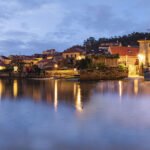Hórreos, crosses and fishermen’s houses
Combarro is one of the fishing villages in Galicia that has best retained most of its traditional architecture. Built entirely of granite, its urban structure and its buildings have survived almost intact until the present day.
Declared an Artistic and Picturesque Site in 1972, Combarro was bequeathed to the San Xoán de Poio Monastery in the 12th century by queen Urraca, and its history remained closely connected to the monastery until the mid-19th century.
Unique architecture
The most iconic feature of Combarro are its hórreos (granaries). These are grain stores that stand on pillars (“pés”) to protect them from the damp and rodents. In this area, they are built of stone and wood, and are known locally as “palleiras”. Around 60 of them survive, of which half are lined up along the shoreline, offering the characteristic picture of the village.
It is, however, the fishermen’s houses that lend the village its distinctive identity. Most are small, terraced dwellings facing the sea. The ground floor was originally used to store the fishing gear, farm tools and occasionally to house a small wine press. Many also have a narrow porch. The first floor has a characteristic balcony which looks out to sea. The balustrades were originally made of wood, iron or stone and were often painted with the colours left over from painting the boats, giving the village its distinctive multicoloured appearance.
Granite art
Another of the village’s distinctive features are the seven granite crosses, erected between the 18th and 20th centuries. Usually situated at crossroads, they have a variety of purposes. They may serve to provide protection, or they may have been donated by individuals in fulfilment of a promise. Several of the crosses in Combarro have a considerable aesthetic quality, such as the Praza da Fonte cross of 1771, depicting a crucifix and St Anne, and the cross in Plaza de San Roque, dating back to 1802. Some also have a stone table (“pousadoiro”) that served as an altar and on which coffins were traditionally placed at funerals. Each year, they are decorated for the traditional Corpus Christi procession.





